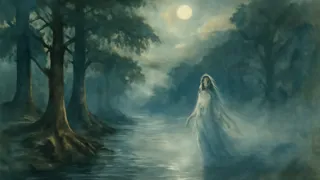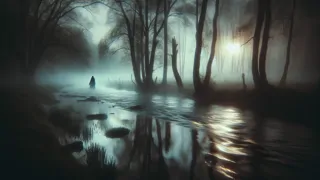Introduction
La Llorona, the legendary weeping woman whose mournful cries echo along rivers at night, embodies a tale of heartbreak and penance passed down through generations of Mexican storytellers. Her silhouette emerges from the mist as the sun dips below the horizon, her white gown stained by the tears she can’t stop shedding. Mothers hush their children when the wind picks up a distant wail, warning them not to venture near the water’s edge after dark. Folklore says she once was a devoted mother who, in a moment of grief and rage, took the lives of her own children before surrendering herself to the currents. Condemned by sorrow and guilt, her spirit roams the riverways in endless search for the children she lost, weeping, weeping with a sorrow that chills the heart. Each trickle of water, each rustle of reeds, seems to carry her lament. Whether warning sailors of unseen dangers or scaring misbehaving children into obedience, La Llorona’s presence remains as potent as moonlight. The legend has woven itself into the cultural fabric of the Rio Grande, Xochimilco, and remote villages far beyond the banks of the largest rivers in Mexico, adapting to local landscapes and customs. In some versions, a brave villager confronts her, offering solace that allows her spirit to rest. In others, she lures the unsuspecting into the depths of the waves, adding fresh victims to her sorrowful procession. The tale’s longevity speaks to its power: loss, regret, and the relentless pursuit of redemption cast a long shadow. In this immersive retelling, we’ll explore La Llorona’s origins, her spectral wanderings, and the enduring lessons her ghostly wails impart. This story invites you into the twilight bustle of river towns, through tangled mangroves, and into the heart of a mother’s unending grief. We will hear whispers of sorrow carried by the wind, and see flickers of white drifting between agave fields and cypress trees. Prepare to journey through memory and myth, as we navigate dark waters haunted by La Llorona’s lament.
Origins of the Weeping Woman
To understand La Llorona’s eternal lament, we must journey back to a time when Aztec temples crowned misty hills, and the rivers were revered as deities. In one version of the tale, a noblewoman named Maria fell fiercely in love with a handsome conquistador, entranced by his foreign words and regal armor. They married in a ceremony that blended Spanish ritual and indigenous song, forging a union that seemed destined to bridge two worlds. But when their passion cooled and the conquistador’s heart wandered, Maria watched him court fishing maidens under the silver moon. Her anger blossomed into heartbreak, and in a moment of blinding grief, she drowned her own children in the sacred river waters. When the blood mixed with the current, the river’s placid surface turned crimson, and her screams rose above the chorus of frogs and crickets. Realizing the horror of her actions, Maria rushed to pull her children’s bodies from the depths, but their forms dissolved into mist. The river, once her sanctuary, became her prison, and Maria’s spirit emerged as La Llorona, the weeping mother cursed to haunt the banks of every river. Even under a scorching sun, villagers can spot her ghostly form—a figure draped in white, eyes hollow with regret, hair tangled by water and wind. She roams tirelessly, driven by a sorrow as vast and deep as the rivers she traverses.

Legends vary from region to region, each adding layers of meaning to La Llorona’s tale. In the highlands of Michoacán, locals believe she haunts Lake Patzcuaro, her wails echoing against volcanic peaks. Fishermen swear they have glimpsed a glowing figure at dawn, her arms reaching out as though cradling unseen children. In the arid North, ranchers speak of dusty washes where her sobs ride the desert breeze, warning unsuspecting travelers of perilous river crossings. Some elders claim that La Llorona’s lament began long before Spanish incursion, tracing her origin to a water goddess betrayed by jealous siblings. This syncretic blending of pre-Colonial beliefs and Catholic guilt deepens the legend’s roots in Mexican culture. Collectors of folklore have documented dozens of accounts where children vanish after hearing her mournful cry. Parents hush their offspring at night, cautioning them to stay indoors lest the ghostly mother mistake them for her lost babes. In towns built upon riverbeds, stone bridges become crossroads of fear and superstition, draped in talismans meant to ward off the wailing spirit. Though the core tragedy remains the same, La Llorona’s story adapts to each landscape, ensuring her presence lives as vividly in desert wastelands as it does along jungle-fringed waterways.
As centuries passed, rituals emerged to appease La Llorona’s restless soul, blending candles, prayers, and offerings of white lilies. Some families gather river stones gathered from childhood play, stacking them at the water’s edge to mark a boundary between the living and the dead. Midwives and curanderos draw protective sigils on doors, fearing the ghost may slip into homes to claim wandering infants. During annual festivals, dancers wearing flowing white garments reenact the moment Maria first glimpsed her children’s lifeless forms. Poets and troubadours compose verses praising the weeping woman, transforming her sorrow into an elegy that resonates through plazas and cantinas. Even modern filmmakers and novelists find inspiration in her plight, weaving her wail into horror films and literary dramas. While some dismiss these tales as superstition, the emotional power of loss and remorse remains undeniable. The weeping mother, once a symbol of scorned love, has become a cautionary spirit, a guardian of familial bonds and a reminder of the cost of unchecked anger. Each retelling pulses with a human truth: grief can transcend life and death, bridging the world of the living and the realm of the spirit. La Llorona’s tears flow as a timeless river, carrying the weight of sorrow, regret, and the hope for forgiveness.
Archaeologists have not uncovered definitive proof of Maria’s existence, but they have documented artifacts that hint at an older water deity whose domain was the cycle of birth, death, and renewal. Ceremonial bowls shaped like crying women, believed to date from the late Postclassic period, suggest that the concept of a mourning mother predated European contact. When Spanish chroniclers recorded native rituals, they described dawn songs sung to placate water gods who ruled both bounty and disaster. Over time, the identity of these deities merged with tales of personal tragedy, forging the figure of La Llorona that we know today. Cross-cultural examinations reveal parallels in South American and Filipino folklore, where women weep for children lost to disease or war. These global connections highlight a universal theme: motherhood intertwined with profound vulnerability. For Indigenous communities, La Llorona’s wail echoes ancestral voices, reminding them of colonization’s wounds and the resilience born of survival. Tour guides on Xochimilco boats tell ghost stories to thrill tourists, but local elders pause at water’s edge to whisper prayers instead of eerie anecdotes. In one such ceremony, shamanic drumming echoes across a moonlit canal, guiding the spirit toward a journey of healing.
Cultural historians argue that the endurance of La Llorona’s legend lies in its ability to adapt to modern sensibilities while retaining its folkloric soul. In urban landscapes, the weeping woman transforms into a tragic figure glimpsed on foggy overpasses and city canals. Digital storytellers have crafted viral videos that claim to show her phantom silhouette under streetlights. Activist collectives repurpose her story as an emblem of women’s pain and resilience in a world that often silences female voices. La Llorona’s image appears on murals, protests, and social media campaigns underscoring maternal hearts broken by injustice. Through each reinterpretation, the legend becomes both a warning and a symbol of solidarity—an invitation to confront grief rather than drown in it. Academics studying collective memory note that La Llorona transcends mere fright; she embodies a collective mourning for lost innocence and fractured histories. And yet, for all her sorrow, La Llorona remains impossibly beautiful, her tears glistening like dewdrops on agave leaves. In darkness or daylight, her call reminds us that some wounds are too deep to heal without remembrance, repentance, and, perhaps, redemption.
Encounters by the River
Many who have walked the banks of the Rio Grande at twilight tell of a chilling presence that descends with the mist. Campers cooking fish over open flames speak of a sudden hush, as lantern light flickers and the fire’s crackle dims to uncertain silence. A few brave souls claim they have glimpsed a faint, white silhouette drifting across the water’s surface before vanishing like smoke. The ghostly figure emits a lament so pure and sorrowful that hardened outdoorsmen find themselves weeping without understanding why. Fishermen refrain from casting nets when they hear the first soft sob, believing that La Llorona might pull their catch—and their spirits—into the dark depths. Children playing near shallow pools stand rooted in place when a distant wail ripples through the night air. Their mothers call them back, whispering warnings learned at their mothers’ knees. The river, usually a source of life and livelihood, transforms into a stage for grief’s grand performance. Yet, amid fear, these encounters create a curious sense of empathy, as if the mournful humming of La Llorona’s sorrow resonates with every heart brimming with loss.

One rainy summer evening in the shadow of Veracruz, a boatman named Diego had his life changed forever by a spectral visitation. He had ferried passengers across the swollen river hundreds of times without incident, but on this night the clouds swallowed the moon whole. As he neared the opposite bank, he heard the unmistakable sound of a child’s cry, small and fragile, drifting from the water. Concerned, he leaned over the oar and peered into the turbid currents, only to see a pale arm reach upward begging for help. Terrified, yet compelled by instinct, Diego dropped his oar and stretched his hand toward the figure. Before he could grasp it, a chilling voice rose above the water, ’¡Mis hijos!’—a mother’s call for her children. Diego’s blood ran cold. He retreated to the boat’s hull, his lantern swinging wildly. By the time he returned to the dock, the river held no trace of a child—just the memory of a weeping woman disappearing into the night.
In Chiapas, a group of amateur folklorists set out to document La Llorona’s cries using audio recorders and infrared cameras. Decked with voice-activated sensors, their equipment filled with static as they sat camped beneath towering ceiba trees. Around midnight, the recorders picked up a faint melody, a cadence of moans laced with melodic undertones. Reviewing the footage, the group spotted a translucent form drifting atop the river like a swan in distress. Unable to identify the source of the lament, they posted their clips online, igniting heated debate among skeptics and believers. Some experts claimed the audio was a natural phenomenon, attributing the sounds to cicadas and wind through reeds. Others defended the recordings, insisting that no earthly noise could convey such piercing sorrow. The group returned to the site night after night, hoping for clarity, but each time they merely captured fragments of a sorrowful symphony. Their cameras would record only darkness, punctuated by the glow of a distant, shapeless light.
Local lore also recounts tales of vigilantes who chased away La Llorona’s wails, carrying charms and reciting prayers beneath the open sky. In Oaxaca, an elderly curandera named Doña Esperanza claimed to have bound the spirit for a single night using a circle of salt and rosemary. She whispered soothing words in Nahuatl and Spanish, promising release if the ghost would cease her eternal lament. According to rumors, the curse lifted briefly, allowing a hush so profound that even cicadas abandoned their song. Villagers celebrated with tamales and mezcal, interpreting the silence as a blessing. Yet, when dawn approached, a solitary tear traced its way down Doña Esperanza’s cheek, and the wind carried her voice again. ’My children,’ she moaned, as if the world could still hear her grief. Though the curandera passed away years ago, travelers still leave offerings of bread and marigolds at the circle’s location, hoping to catch one night of tranquility.
River boat tours in the canals of Xochimilco blend festivity with fright by reenacting La Llorona’s call as visitors drift under paper lanterns. Tour guides dramatize the legend with whispered narratives, urging tourists to stay alert to any restless spirit. As the trajineras pass beneath arched stone bridges, musicians pause their jarana guitars, and the oars cut through water in perfect silence. A lone trumpet player might strike a haunting minor chord, simulating the ghostly lament. The sudden hush unsettles passengers, the night air pregnant with anticipation. Some claim that the faint outline of a woman appears behind them in the lantern light, only to dissolve when shadows shift. Others insist they feel a cold touch upon their necks, as if icy fingers traced their spine. Despite warnings, thrill-seekers return year after year, hoping for a glimpse of the weeping mother. Yet, whether entertainment or genuine ordeal, the legend’s power remains undiminished.
Even in a world flooded with digital distractions, La Llorona’s legend thrives, carried by word of mouth, podcasts, and streaming documentaries. Listeners tune in to ghost hunters debating the credibility of various sightings, dissecting every echo and reflection. Social media feeds fill with filtered images of candlelit altars by rivers, tagged #WeepingMother and #RiverGhost. Poets tweet snippets of her lament, coupling haunting stanzas with images of mist and moonlight. Despite the convenience of modern media, the core of La Llorona’s story persists: the universal ache of loss and the desperate hope for absolution. For every skeptic who calls her tale mere superstition, there stands an elder who beckons young ones back indoors as dusk settles along the waterway. They know that no scientific argument can quell the sorrow that ripples through the night. As long as mothers hold their children close and artists paint her face on crumbling walls, the weeping woman will walk the banks forever, reminding us of the price of unchecked despair.
Redemption at Dawn
As the first rays of sunrise dance across water’s surface, a hush descends upon the riverbank, signaling a moment of fragile possibility. Some stories claim that in these liminal moments, La Llorona’s sorrow softens, and a faint smile flickers across her ghostly features. She drifts toward the east, where crimson dawn meets morning mist, her tears falling like dew onto reeds and lilies. In rural villages, priests hold sunrise masses by the water, reciting prayers meant to guide lost souls toward forgiveness. Candles line the banks, their flames trembling as birds begin their morning chorus. Children gather at dawn with fresh bread and milk, hopeful that their offerings might ease the curse of the weeping woman. Few have seen her accept these gifts—few dare to stay past the first light—but legends persist that her spirit moves toward peace when greeted with compassion. Farmers swear that fields near a placid river yield richer harvests after these dawn rites. In one remote hamlet, a young widow led such a ceremony for three mornings, each time hearing the softest of sighs rather than anguished wails. Her courage, the elders say, unlocked a fleeting moment of serenity, and the river sang a different tune, hinting that La Llorona’s heart could still find rest.

Others tell of a boy named Luis who encountered La Llorona just before sunrise and offered her forgiveness in place of fear. He had ventured too close to the water’s edge, chasing a stray dog, when the night’s chill magnified her hollow cry. While onlookers scrambled to safety, Luis dropped to his knees, tears in his own eyes, and spoke words he barely understood: ’I’m sorry for your loss, and I hope you find your children.’ The ghostly form paused, her gaze sweeping across him with a mixture of surprise and longing. For a heartbeat, the world stood still—no breeze stirred, no bird dared to sing—and then La Llorona bowed her head. A single tear traced its way down each cheek and landed at Luis’s feet, steaming like a drop of liquid silver. Then, as dawn broke, she turned away, her image dissolving into the golden mist. Luis returned home with wet footprints behind him, and though skeptics questioned his account, he carried an unshakable sense of having witnessed a miracle. His story spread along the river’s course, inspiring others to approach the legend not with dread, but with empathy. In time, his name became entwined with La Llorona’s redemption—proof that a mother’s boundless sorrow could be met with human kindness.
In creative circles, artists have sought to reframe the narrative of La Llorona, focusing on her capacity for love rather than just her pain. Painters render her figure not as a ghastly specter, but as a dignified mother kneeling by the water with arms outstretched in yearning. Sculptors carve her visage with gentle lines, capturing both anguish and grace. Writers compose poems from her perspective, revealing the tenderness she once lavished upon her children before tragedy struck. A theater troupe in Guadalajara staged a play that depicted Maria’s remorseful transformation, culminating in a scene where the audience joins in a chorus of forgiveness. Some performances end with the water cascading behind the actors, symbolizing a cleansing baptism for both mother and community. Through art, La Llorona emerges not just as a warning, but as a call to acknowledge shared grief and build bridges of compassion. Mental health advocates even reference her story as a metaphor for the enduring power of forgiveness in healing trauma. By listening to her cries and confronting the darkness they evoke, communities can begin to chart a path toward reconciliation.
Academic scholars debate whether La Llorona’s redemption arc dilutes the cautionary force of the original legend or enriches its moral depth. Some insist that her endless crying must remain a stark reminder of the consequences of uncontrolled wrath. Others argue that showing her path to forgiveness introduces a note of hope into a story otherwise steeped in despair. Conferences on folklore and gender studies dissect the dual nature of La Llorona as both victim and villain, mother and mourner. Many agree that redemption does not erase the pain but acknowledges its weight, offering a model for transformation through understanding. In communities along the Rio Grande, elders pass down both versions of the tale in tandem, teaching that sorrow and solace can coexist. In one school project, children wrote letters to La Llorona, expressing empathy and pledging to honor her children’s memory by safeguarding their own kin. These letters were cast onto paper boats and floated at dawn, a vigil bridging the living and the lost. Watercolor illustrations of these letters appear in local museums, a testament to the legend’s evolving resonance.
Ultimately, La Llorona’s story remains fluid, shaped by each person who hears her nightly cry or contemplates her silent vigil at sunrise. She teaches that grief can bind us to the physical world, but compassion has the power to loosen those chains. In whispering her name by candlelight or offering a silent prayer as the river flows, we participate in an ancient dialogue between the living and the departed. La Llorona may wander forever beneath starry skies, but every act of understanding faintly illuminates her path toward peace. Through sorrow and song, through tears and ritual, the weeping woman invites us to look beyond fear and meet her lament with the warmth of our humanity. In that fragile meeting of grief and grace, we find the true heart of the legend—a mother’s love that even death cannot extinguish.
Conclusion
In this timeless legend, La Llorona stands as a mirror to our own capacity for sorrow, regret, and, ultimately, compassion. Each whisper of her lament drifting over river currents beckons us to remember that grief is as natural as the water that flows beneath moonlight. Through the haze of mist and the murmur of reeds, her story reminds us that the darkest moments of human experience can give rise to acts of empathy and reconciliation. Whether we encounter her as a cautionary spirit warning against uncontrolled anger or as a tragic mother yearning for forgiveness, La Llorona’s journey remains profoundly human in every telling. Her mournful silhouette, clad in white, haunts both rural and urban waterways, bridging time and culture with its emotional resonance. By offering her our understanding—through whispered prayers at dawn, through small ceremonies by riverbanks, or through art that reimagines her sorrow with beauty—we honor both her pain and her enduring strength. In embracing the legend’s complexity, we embrace the universal themes of loss and healing that bind us across generations. La Llorona’s tears, once the product of a mother’s irreversible mistake, become symbols of hope when met with kindness. In doing so, we allow the weeping woman to transition from a figure of fear into a living testament of redemption’s power. May her sorrow guide us not into despair, but toward a deeper recognition of our shared humanity and the healing that emerges when sorrow and mercy converge. As long as rivers flow and the moon casts its silver glow, her lament will echo across water and hearts alike. And in that echo we find a call not just to listen, but to act—with compassion that knows no bounds.


















